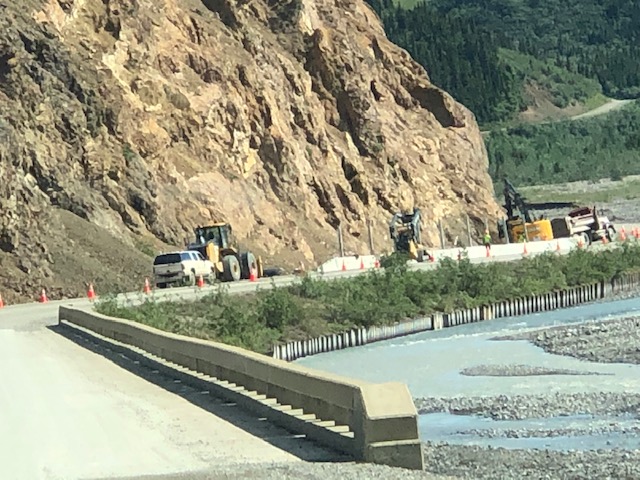DCC Questions Toklat Bluffs Rockfall Mitigation
Prompted in part by member concern, DCC has been pressing the National Park Service regarding its decision-making process for mitigating rockfall at Toklat Bluffs – a rock face just east of the Toklat River bridges on the Denali park road. The project was identified as a priority by the federal lands Unstable Slope Management Program as the second greatest safety threat along the park road. NPS authorized the project after labeling the project a Categorical Exclusion under the National Environmental Policy Act (NEPA), meaning that the project did not require an extensive environmental analysis. The project involves creating a rock catchment area at the base of the cliff and shrinking the travel roadway to 24 feet in accordance with Denali’s Road Design Guidelines. Most controversially, it involves the active removal of a large volume of rock from the cliff face itself (“scaling”).
DCC is frustrated about the NPS work at Toklat Bluffs for several reasons. First, we question the need for the project. Long-time drivers of the park road do not feel Toklat Bluffs is a particularly dangerous area for rockfall. To the degree that rocks do fall down, it seems a much less intrusive, catchment-only project could have addressed the issue. NPS cites the conclusions of the Unstable Slope Management Program (USMP) as justification for the larger project, but that program information is not available publicly, making it impossible for DCC – or any other third party – to understand why there is a discrepancy between the USMP’s conclusions and the decades-long experience of many drivers of the park road. The USMP, the project design, and the work itself are all paid for and managed by the Federal Highway Administration (FHWA), which has a long history of devising inappropriate projects on the park road. DCC worries that the availability of funds from FHWA may be a driving force for road projects, rather than actual safety or maintenance needs.
Second, the project is taking place in an unusually important area of habitat. This cliff face represents one of the few places that visitors can see Dall sheep close to the park road. It is also one of the identified “sheep gaps” for which vehicle spacing is a tightly managed standard within the Vehicle Management Plan; a standard that will be comprehensively violated as part of the project. In addition, the rock face is scenically interesting as a distinct geologic feature along the park road. For these reasons alone the use of a Categorical Exclusion seems ill-advised, and contrary to NPS’s own guidelines.
Using a Categorical Exclusion, NPS does not have to look at either the short-term or long-term impacts of the project. While the authorization made a nod to the Dall sheep’s use of the rock face by restricting work to mid-summer dates outside of lambing season, the long-term repercussions are unknown. If the project unintentionally removes important resting ledges the sheep could stop using the area altogether, depriving the sheep of a place of safety and park visitors of a chance to see them close to the road. Potential effects on small rock-dwelling animals like pikas and marmots are completely unknown.
The questionable use of Categorical Exclusions by NPS has grown alarmingly in recent years. In a July 17, 2021, letter to Deputy Superintendent Brooke Merrell, DCC made three requests to NPS in hopes of improving communication and public accountability for future road projects.
- We would like NPS to publish on the NEPA compliance website any Categorical Exclusions (CEs) for projects that would have a physical effect on the park road or backcountry areas of Denali, or that would be disruptive for visitors. There were a number of years where NPS routinely provided most CEs on PEPC; it is often the only way the public can find out about projects prior to the start of work. For larger construction projects that are going to have significant impacts on road travel or that extend beyond existing development disturbance, we encouraged NPS to hold informational public meetings. NPS has done this in the past for larger projects that were nonetheless covered by a CE..
- We would like NPS to make public the data and information used to make decisions for these CEs. The only data sources we have access to regarding the Toklat Bluffs are the people who regularly drive the road, all of whom agree this project is unnecessary. NPS instead points us to a source that is unavailable to us – the Unstable Slope Management Program. Why shouldn’t the public have access to the information used by managers to make decisions about our parks?
- Given the expected pace of road construction activity over the next few years, DCC would like to see at least a programmatic EA describing the likely projects, providing alternatives, and particularly looking at the cumulative impacts to visitor experience, wildlife, soundscapes, wilderness, and gravel resources. Such a document would really help both NPS and the public understand the needs of the park road, and hopefully would stimulate thinking regarding the least intrusive means of accomplishing the necessary work. We understand that this program may be a moving target if conditions change, but alterations within the program would certainly be an appropriate use of CEs.
We will update our members and readers when NPS responds. We are very interested in observations regarding Toklat Bluffs during and after the current project. Please send any comments to dcc@denalicitizens.org.


